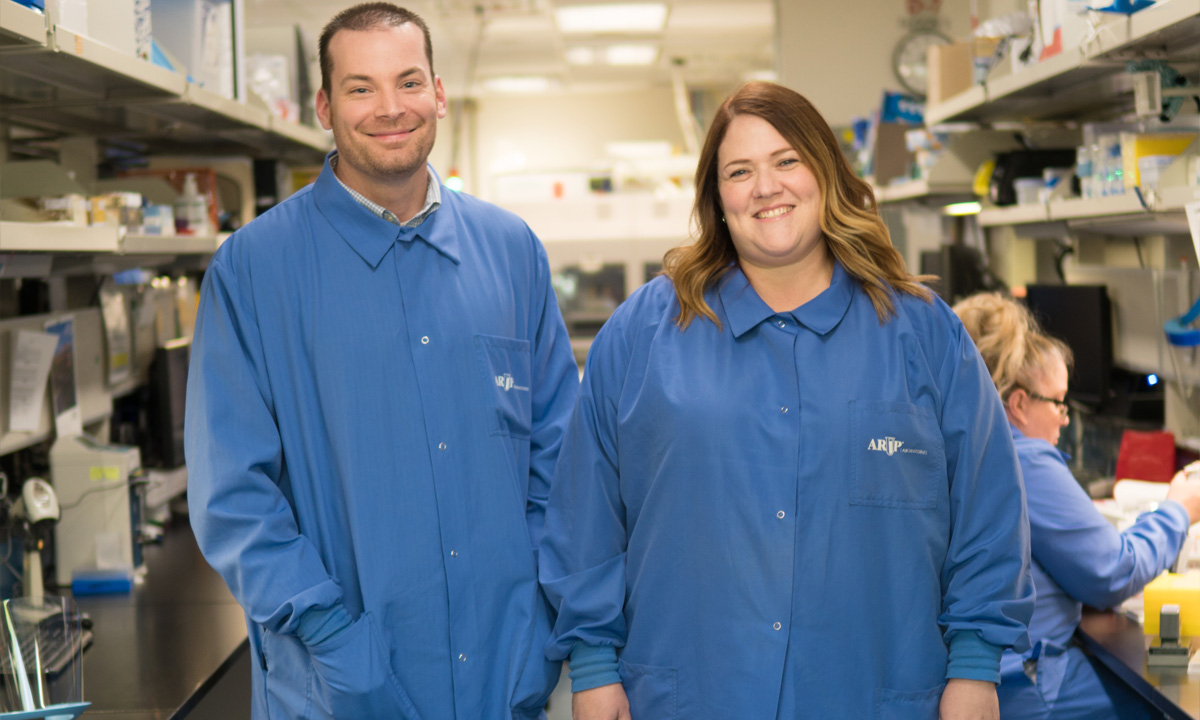
Bryan Stromberg stumbled into labwork while preparing to study medicine. Labwork fascinated him, so he stayed. He is a technical supervisor in ARUP’s Autoimmune Immunology I Lab, pictured here with colleague Kathryn Olson, technical supervisor in the Microbial Immunology I Lab.
Bryan Stromberg calls the work in his laboratory, Autoimmune Immunology I, "fascinating" because medical science is still figuring out why the body attacks itself. Having entered college with plans to work later as a doctor or physician assistant (PA), he changed his mind after experiencing the lab bench, and chose certification in immunology. These days he is a technical supervisor; he tells us here why labwork holds his interest.
How would you explain what happens in your lab?
Autoimmune Immunology I is a high-complexity laboratory that tests for various autoimmune diseases, a rapidly growing field. It is fascinating to try to figure out why the body’s immune system attacks healthy cells. Bacteria and viruses can make you sick, but what makes your immune system do harm? Some of the diseases we’re testing for include lupus; myositis (inflammation of the muscles caused by a malfunctioning immune system); Sjögren syndrome (causes dry eyes and mouth); and vasculitis (inflammation of the blood vessels). We also do many more tests, such as vaccine-response testing, which challenges patients with vaccines to see if their immune systems mount the appropriate response.
Most of our testing is manual and requires highly skilled personnel to interpret. We use many methodologies—indirect fluorescent antibody (IFA), immunoblot, multi-analyte fluorescence detection (MAFD), immunoprecipitation, and immunodiffusion—within the laboratory to complete testing. The most commonly used methodology in the laboratory, IFA, is used to test for an antibody, using fluorescent dye added to tissue. The tissue is combined with a specific antigen (microbe, or other), then the result can be identified with microscopy.
Bryan Stromberg“It is fascinating to try to figure out why the body’s immune system attacks healthy cells. Bacteria and viruses can make you sick, but what makes your immune system do harm?”
Technical Supervisor, Autoimmune Immunology I Lab
Myositis testing is one of the most challenging and labor-intensive tests performed in the lab. It utilizes four techniques (IFA, MAFD, immunoprecipitation, and immunoblot) to obtain results for numerous antibodies, and requires interpretation by a medical director to determine the final results. It’s a great example of collaboration between the laboratory and medical directors to provide patient care.
What’s a typical day?
In the morning, technologists review the schedule to find out the tests they’ll be performing. They collect specimens that arrived with testing orders and proceed with testing. When using IFA, once technologists complete testing, they go to the microscope room and examine slides under a scope to interpret the results.
One of the coolest things about IFA testing is the people performing the testing determines the results. They look under the microscope, see what is fluorescing, and discern the positive or negative antibody reaction.
The IFA testing process tends to be pretty similar regardless of the antibody being tested for; however, the end product (what we are looking for using the microscope) varies greatly and provides great variety to those performing the testing in the lab. Every day is truly different.
How did you get into lab work?
In college, I intended to be a physician or a PA, something patient-facing. After getting my zoology degree, pre-med focus, from Weber State, I came to ARUP as a tech trainee. I thought this would be a temporary stopping point and I would gain good experience that I could apply when working to become a physician/PA. However, once I got into the laboratory, I really enjoyed my work, picked it up pretty quickly, and got certified in immunology. If I had it to do all over again I’d go immediately into medical technology/medical laboratory science.
What keeps you interested?
In general, lab testing is kind of a black box to everyone outside of a laboratory. You go to a doctor, get tested, they get results, they treat you. That’s all, right?
After you start here, you realize how important lab results are to treatment. I think my passion for laboratory work really came alive knowing that, so I have stayed here since 2002.
In a lab, it’s a different challenge every day. In a changing field of knowledge such as autoimmune-related testing, keeping up with advancements in laboratory testing is a big part of that. I enjoy looking for ways to improve the work the lab is doing; that’s exciting.
Catherine Arnold, Science Communications Writer
Related blog
"Lab Jobs and Histotechnology: How Switching Careers Helped One Technologist"
Want to see more lab news? Check out Magnify magazine. Later this summer, find more Lab Spotlights there too!
















